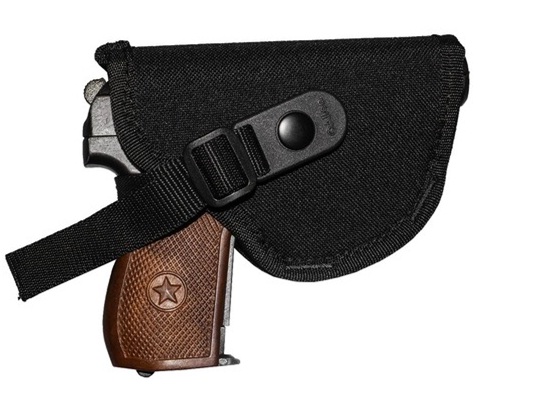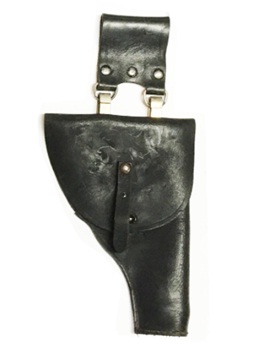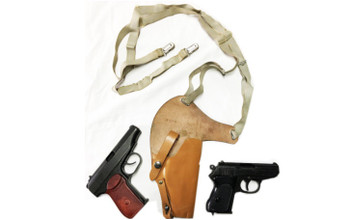OWB, IWB, Shoulder Gun Holsters and More Breakdown, Pros and Cons, and Other Points
Jul 3rd 2021
SARCO, Inc., is not simply a firearms and parts company. We’re a full-service, front to back outfitter with the parts, accessories, and information our clients need to service and support their collections.
Many of our clients come to us looking for practical gun holsters to fit their favorite firearms. Whether as a part of a historical collection (your 1911 will look mighty nice hanging from a leather shoulder gun holster) or for everyday use, we have what you need in effective, comfortable, safe holster options.
Carrying a Firearm
Many citizens choose to carry firearms for self defense, and in many ways, the holster you choose to pair with your pistol or revolver is nearly as important as the firearm itself. It must balance a delicate suite of features to ensure that it is safe, secure, comfortable and more.
-Safety and security
Safety and security are the two most important features of any holster, period. Without these, it doesn’t matter if your holster is comfortable, easily concealable, compatible with a wide range of clothing, or even if it prevents printing.
Your holster should afford a sure fit for your specific firearm that makes it effectively impossible to remove or unseat it except by a deliberate action on the part of the wearer. It should also fully enclose the trigger and trigger guard and completely prevent access to it from the outside. Moreover, it should balance well on your body and not shift or move as you go about your day.
-Comfort
After you have ensured that your holster of choice provides a safe, secure fit for your pistol, you can start to evaluate it on the grounds of comfort. After all, no one wants to wear an uncomfortable holster with harsh angles for any prolonged period of time. It’s best to be comfortable if you can be.
-Compatibility with different clothing
Depending on whether you intend to carry concealed or carry openly, you might want a holster that is compatible with many different styles of clothing. For example, some holsters are most compatible with formal and professional clothing, whereas others work well with casual and even athletic attire.
-Reholstering
Unfortunately, accidents can happen when reholstering a firearm, which is why you must always practice great care and attention when replacing your firearm in its holster. All other things being equal, it’s best to choose a holster that doesn’t offer any impediments to reholstering, is ergonomically designed and easy to use.
-Durability
Durability is also a highly valuable quality in a holster, and some full grain leather holsters and even Kydex holsters offer a lot to love in this respect. A holster must be not only reliable but also made to a high standard of quality so that none of its components will fail when you need them most.
-Concealed carry vs. open carry
You’ll also need to make an important decision up front about whether you want to carry open or concealed. It will dictate what permits you need to acquire and what type of holster you will need. Concealed carry permitting varies by state and locality, but some jurisdictions allow for open carry without additional permitting - be sure of all applicable laws and regulations before carrying, and make sure both your holster and firearm are legally secured.
With respect to this, some holsters can be converted from concealed to open carry, which might provide you with a bit of additional value as well.
-Bells and whistles
If you can assure yourself that you’ve met all other necessary requirements, then you can start to evaluate a holster based on other considerations as well. Look for features like a variety of different options for how you can carry it, spare space for extra magazines, or the ability to accommodate trigger guard mounts or optics.
Once you’ve squared that away, take a look at the following different options in holsters and evaluate them on each of their subjective merits. Every style disclosed here has its own unique benefits as well as a list of drawbacks that you should consider before making a decision.
Outside Waistband Holsters: AKA OWB Holsters
Outside waistband holsters are also known as OWB holsters and, as you might have guessed, are intended to be worn outside the waistband. This makes some belt holsters outside waistband holsters of sorts.
Probably the majority of holsters designed for open carry are some form or other of outside waistband holster, and along with their prevalence come a distinct number of beneficial attributes.
Pros of OWB Holsters

●Compatible with many full size handguns and revolvers
If you carry a pistol with a big frame or a revolver with a long barrel, you might be limited in what type of holster you can use. However, there’s probably an OWB holster out there that’s big enough for your purposes.
●Generally suitable for open carry
Concealed carry is prohibited in some places where open carry may be allowed. Despite the fact that some don’t like the lack of discretion associated with OWB holsters, they’re the most practical option for open carry.
●Comfortable when sitting
Because they sit outside your belt and waistband and don’t dig into your side, they’re one of the most comfortable holster options while sitting.
●Typically make it practical to carry along additional accessories
Because you can have more room with most OWB holsters, there’s also often room for additional accessories, like extra magazines.
●Many so-called quickdraw holsters are types of OWB holsters
OWB holsters also afford excellent access to your firearm. Some of them, styled as quickdraw holsters, offer the best access of all.
Cons of OWB Holsters
●Generally not suitable for concealment
Obviously, one of the greatest drawbacks of OWB holsters is that they’re usually not suitable for concealment, so if you have a CCW permit, you might be looking for something else.
●OWB holster bulk potentially limits your choice of clothing because
Because OWB holsters are typically not designed with any sort of emphasis pon discretion, they can be pretty bulky. This can make them pretty limiting when it comes to choosing clothing that can be worn with them.
Inside Waistband Holsters: AKA IWB Holsters
Inside waistband holsters are the counterpart to OWB holsters, and are sometimes styled as IWB holsters. While they afford many of the same advantages as OWB holsters, IWB holsters are superior for concealment, and some of them can even be carried outside the waistband, offering the best of both worlds.
Pros of IWB Holsters
●They still offer excellent access to a firearm, but are better for concealment
The greatest advantage of IWB holsters is that they’re superior for concealment, and as such as some of the most popular styles of concealed carry holsters out there. However, like OWB holsters, they still offer excellent access to the firearm.
●Compatible with a wider range of clothing
Because IWB holsters tend to be slimmer and designed specifically for concealment, you will probably have more flexibility with what clothing you can wear in concert with them.
●You don’t need a special belt; you might not need a belt at all
Some IWB holsters may not require the use of a belt. However, due to the size and heft of some OWB holsters, you might need a special belt just to use them.
Cons of IWB Holsters
●You might need to up your pants size a bit
Since IWB holsters sit within your waistband, you may need to get pants that are a size or two larger than you would normally wear, in order to accommodate the extra bulk.
●May not be comfortable for long periods of time
Depending on the size and the weight of the handgun you carry, an IWB holster can be more or less uncomfortable when worn for an extended period of time. Generally speaking, smaller, lighter, compact handguns are more comfortable carried in this manner.
●Less suitable with larger handguns and revolvers
Truth be told, IWB holsters are downright unsuitable for some larger handguns or revolvers with long barrels because there is nowhere for all that gun to go. They might be suitable standing, but that changes sitting down.
Shoulder Gun Holsters
Shoulder gun holsters create the classic image of a detective or government official practicing concealed carry under their jacket or over a part of their uniform. The shoulder holster typically consists of a sort of harness that is worn over the shoulders and seats the firearm on the user’s non-dominant side. Some types of shoulder gun holsters are known as cross draw holsters for the manner in which the firearm is drawn.
Pros of Shoulder Gun Holsters
●Excellent option for concealed carry, and can be very comfortable
When you’re wearing the right clothing, a shoulder gun holster is an excellent option for concealed carry and will not print. It can also be quite comfortable.
●They often have room for other accessories
Because you won’t be tight for space, some shoulder holsters actually have space built right into them for spare magazines and other accessories.
●Plenty of room for larger handguns
By their very nature and how they are oriented on your body, shoulder holsters typically afford a lot of room for larger handguns.
●They’re comfortable almost no matter what you’re doing
Shoulder holsters can be worn laden and comfortably but not just while you’re standing. A quality leather shoulder holster can also be worn comfortably while you're sitting, reaching, or even semi-active.
Cons of Shoulder Gun Holsters
●They’re not great quick draw options
Because they require you to effect a nearly unnatural, deliberate attempt to reach for and draw the gun, they’re not great as quick draw holsters.
●They might require an additional layer of clothing
It’s very difficult to conceal a gun in a shoulder holster unless you are wearing a jacket or coat. That said, a shoulder holster can potentially be used for open carry, in which case this might not be an issue.
●Requires additional training to use safely
There is also the “cross draw” problem of using shoulder holsters, which requires the user to draw the firearm and then sweep the muzzle across the front of his body. This is very dangerous without the proper training. As a result, shoulder holsters are typically only advisable for use by those who are very familiar with them and who have received the proper training.
Belly Band Holsters
Another type of holster that is popular among those who need comfortable concealment is a holster that is known as a belly band. They are so called because they typically sit across a user’s midsection and secure the firearm at the front, although they can be adjusted up or down and the gun repositioned accordingly.
Pros of Belly Band Holsters
●Afford good access to the firearm
Typically it is easy to access a firearm carried in a belly band holster.
●Compatible with a fair range of clothing
They’re not compatible with all styles of clothing, but they’re better with casual clothing than most alternatives.
●Some designs are suitable for larger handguns and have extra space
Because they can sit higher on the body, they are not as limiting as IWB holsters when it comes to size.
Cons of Belly Band Holsters

●Models that allow the firearm to contact skin can be very uncomfortable and potentially damaging to the firearm
They can be very uncomfortable when worn for prolonged periods of time, especially if they allow the firearm to contact your skin. Additionally, oil and sweat from your skin can damage the firearm if they come in contact with it.
●They can shift or move on the body if they are not secured properly
Some belly band holsters have proven problematic because they can tend to shift or migrate on the body.
Visit Us for Assistance
In addition to these four types of holsters, there are also ankle holsters, bag holsters, pocket holsters, thigh holsters and more, and each of these, though less common, has its own advantages and disadvantages as well.
If you’re interested in getting our assistance or would like some recommendations, feel free to come visit us at our location in Easton, Pennsylvania. If you can’t take a look through our online collection here and remember, we’re only a call away. You can reach us at 610-250-3960 anytime you need assistance.

